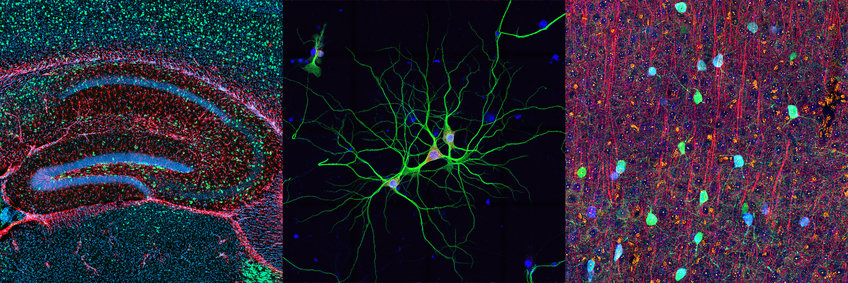
Publications of Ulrike Müller
All genres
Journal Article (25)
1.
Journal Article
Amyloid precursor protein knockout diminishes synaptic vescicle proteins at the presynaptic active zone in mouse brain. Current Alzheimer Research 11, pp. 971 - 980 (2014)
2.
Journal Article
Selective glycine receptor alpha 2 subunit control of crossover inhibition between the on and off retinal pathways. The Journal of Neuroscience 32 (10), pp. 3321 - 3332 (2012)
3.
Journal Article
: APP anterograde transport requires Rab3A GTPase activity for assembly of the transport vesicle. The Journal of Neuroscience 29 (46), pp. 14534 - 14544 (2009)
4.
Journal Article
Embryonic stem cell-derived neurons as a cellular system to study gene function: Lack of amyloid precursor proteins APP and APLP2 leads to defective synaptic transmission. Stem Cells 26 (8), pp. 2153 - 2163 (2008)
5.
Journal Article
: The secreted beta-amyloid precursor protein ectodomain APPs alpha is sufficient to rescue the anatomical, behavioral, and electrophysiological abnormalities of APP-deficient mice. Journal of Neuroscience 27 (29), pp. 7817 - 7826 (2007)
6.
Journal Article
Regulated intramembrane proteolysis of amyloid precursor protein and regulation of expression of putative target genes. EMBO Reports 7 (7), pp. 739 - 745 (2006)
7.
Journal Article
Hyperekplexia phenotype of glycine receptor alpha 1 subunit mutant mice identifies Zn2+ as an essential endogenous modulator of glycinergic neurotransmission. Neuron 52 (4), pp. 679 - 690 (2006)
8.
Journal Article
Spinal prostaglandin E receptors of the EP2 subtype and the glycine receptor alpha 3 subunit, which mediate central inflammatory hyperalgesia, do not contribute to pain after peripheral nerve injury or formalin injection. Pain 126 (1-3), pp. 46 - 53 (2006)
9.
Journal Article
Characterization of the glycinergic input to bipolar cells of the mouse retina. European Journal of Neuroscience 23 (2), pp. 350 - 364 (2006)
10.
Journal Article
Keratinocytes from APP/APLP2-deficient mice are impaired in proliferation, adhesion and migration in vitro. Experimental Cell Research 312 (11), pp. 1939 - 1949 (2006)
11.
Journal Article
Lengthening of G2/mitosis in cortical precursors from mice lacking beta-amyloid precursor protein. Neuroscience 130 (1), pp. 51 - 60 (2005)
12.
Journal Article
: Spinal inflammatory hyperalgesia is mediated by prostaglandin E receptors of the EP2 subtype. Journal of Clinical Investigation 115 (3), pp. 673 - 679 (2005)
13.
Journal Article
Apoptotic cell death influences the signaling activity of the amyloid precursor protein through ShcA and Grb2 adaptor proteins in neuroblastoma SH-SY5Y cells. Journal of Neurochemistry 90 (6), pp. 1359 - 1370 (2004)
14.
Journal Article
beta-amyloid precursor protein intracellular domain (AICD) strongly enhances resting free cytosolic calcium levels. Neurobiology of Aging 25 (Suppl. Suppl. 2), p. S81 - S81 (2004)
15.
Journal Article
Cortical dysplasia resembling human type 2 lissencephaly in mice lacking all three APP-family members. Neurobiology of Aging 25 (Suppl. Suppl. 2), pp. S81 - S82 (2004)
16.
Journal Article
Soluble form of amyloid precursor protein regulates proliferation of progenitors in the adult subventricular zone. Development 131 (9), pp. 2173 - 2181 (2004)
17.
Journal Article
: GlyR alpha 3: An essential target for spinal PGE(2)-mediated inflammatory pain sensitization. Science 304 (5672), pp. 884 - 887 (2004)
18.
Journal Article
Diversity of glycine receptors in the mouse retina: Localization of the alpha 2 subunit. Journal of Comparative Neurology 477 (4), pp. 399 - 411 (2004)
19.
Journal Article
Cortical dysplasia resembling human type 2 lissencephaly in mice lacking all three APP family members. EMBO Journal 23 (20), pp. 4106 - 4115 (2004)
20.
Journal Article
gamma-Secretase activity requires the presenilin-dependent trafficking of nicastrin through the Golgi apparatus but not its complex glycosylation. Journal of Cell Science 116 (6), pp. 1127 - 1136 (2003)